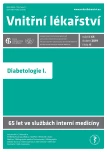Insulin pump therapy: education and its goals
Authors:
Kateřina Štechová
Authors‘ workplace:
Interní klinika 2. LF UK a FN Motol, Praha
Published in:
Vnitř Lék 2019; 65(4): 248-255
Category:
Overview
Insulin pump therapy represents nowadays the way of insulin administration most similar to the physiological insulin secretion. This form of intensified insulin regime is used mostly (but not exclusively) in type 1 diabetes patients. Insulin pump therapy can be efficiently combined with continuous glucose monitoring. Even there are available insulin pumps which can serve as continuous glucose monitoring signal receiver themselves and are capable to stop automatically basal insulin infusion to prevent hypoglycemia. By this technological combination it is possible to reach near normoglycemia without increasing the risk of severe hypoglycemia. In the Czech Republic this therapy is covered by insurance when defined indication criteria are fulfilled. To reach this therapy full potential the patient as well as the professionals must be trained properly to know all technical aspects of this therapy as well as it is necessary to gain further knowledge. Particularly important is knowledge on food nutrition content and on the glycemic effect of different meals. All these factors are discussed in details in the paper.
Keywords:
Diet – Education – insulin pump – therapeutic success – treatment indications
Sources
- Štechová K (ed) et al. Technologie v diabetologii. Maxdorf: Praha 2016. ISBN 978–80–7345–479–1.
- Nathan DM, Genuth S et al. Diabetes Control and Complications Trial Research Group, The effect of intensive treatment of diabetes on the development and progression of long-term complications in insulin-dependent diabetes mellitus. N Engl J Med 1993; 329(14): 977–986. Dostupné z DOI: <http://dx.doi.org/10.1056/NEJM199309303291401>.
- Metodika k Úhradovému katalogu VZP – ZP platnému od 1. 7. 2018, část P, Skupina 11 – Pomůcky pro diabetiky. Dostupné z WWW: <https://prod-publicweb-media.azureedge.net/media/Default/dokumenty/ciselniky/metodika_1002.pdf>.
- Rušavý Z. Doporučený postup léčby inzulínovou pumpou. DMEV 2012; 15(2): 108–110.
- Česká diabetologická společnost (ČDS). Registr inzulinových pump. Dostupné z WWW: <http://www.diab.cz/registr-inzulinovych-pump>.
- National Institute for Health and Care Excellence (NICE). Continuous subcutaneous insulin infusion for the treatment of diabetes mellitus. Technology appraisal guidance [TA151]. Dostupné z WWW: <https://www.nice.org.uk/guidance/ta151/chapter/2-Clinical-need-and-practice>.
- McKnight JA, Wild SH, Lamb MJ et al. Glycaemic control of Type 1 diabetes in clinical practice early in the 21st century: an international comparison. Diabet Med 2015; 32(8): 1036–1050. Dostupné z DOI: <http://dx.doi.org/10.1111/dme.12676>.
- Pollard DJ, Brennan A, Dixon S et al. Cost-effectiveness of insulin pumps compared with multiple daily injections both provided with structured education for adults with type 1 diabetes: a health economic analysis of the Relative Effectiveness of Pumps over Structured Education (REPOSE) randomised controlled trial. BMJ Open 2018; 8: e016766. Dostupné z DOI: <http://doi: 10.1136/bmjopen-2017–016766>.
- Škrha J, Šumník Z, Pelikánová T et al. Doporučený postup péče o diabetes mellitus 1. typu. DMEV 2016; 19(4): 156–159.
- Yeh HC, Brown TT, Maruthur N et al. Comparative effectiveness and safety of methods of insulin delivery and glucose monitoring for diabetes mellitus: a systematic review and meta-analysis. Ann Intern Med 2012; 157(5): 336–347. Dostupné z DOI: <http://dx.doi.org/10.7326/0003–4819–157–5-201209040–00508>.
- Thabit H, Hovorka R. Continuous subcutaneous insulin infusion therapy and multiple daily insulin injections in type 1 diabetes mellitus: a comparative overview and future horizons. Expert Opin Drug Deliv 2016; 13(3): 389–400. Dostupné z DOI: <http://dx.doi.org/10.1517/17425247.2016.1115013>.
- [REPOSE Study Group]. Relative effectiveness of insulin pump treatment over multiple daily injections and structured education during flexible intensive insulin treatment for type 1 diabetes: cluster randomised trial (REPOSE). BMJ 2017; 356: j1285. Dostupné z DOI: <http://dx.doi.org/10.1136/bmj.j1285>.
- Pelikánová T, Bartoš V (eds). Praktická diabetologie. 6. ed. Maxdorf: Praha 2018. ISBN 978–80–7345–559–0.
- Galderisi A, Schlissel E, Cengiz E. Keeping Up with the Diabetes Technology: 2016 Endocrine Society Guidelines of Insulin Pump Therapy and Continuous Glucose Monitor Management of Diabetes. Curr Diab Rep 2017; 17(11): 111. Dostupné z DOI: <http://dx.doi.org/10.1007/s11892–017–0944–6>.
- Stechova K, Vanis M, Tuhackova M et al. Lessons Learned from Implementing a New Testing/Educational Tool for Patients Using an Insulin Pump. Diabetes Technol Ther 2018; 20(8): 524–530. Dostupné z DOI: <http://dx.doi.org/10.1089/dia.2018.0095>.
- King AB. Reassessment of insulin dosing guidelines in continuous subcutaneous insulin infusion treated type 1 diabetes. Curr Diab Rep 2014; 14(6): 503. Dostupné z DOI: <http://dx.doi.org/10.1007/s11892–014–0503–3>.
- King AB, Kuroda A, Matsuhisa M et al. A Review of Insulin-Dosing Formulas for Continuous Subcutaneous Insulin Infusion (CSII) for Adults with Type 1 Diabetes. Curr Diab Rep 2016; 16(9): 83. Dostupné z DOI: <http://dx.doi.org/10.1007/s11892–016–0772–0>.
- Gilbertson HR, Reed K, Clark S et al. An audit of the dietary intake of Australian children with type 1 diabetes. Nutr Diabetes 2018; 8(1): 10. Dostupné z DOI: <http://dx.doi.org/10.1038/s41387–018–0021–5>.
- Chillarón JJ, Flores Le-Roux JA, Benaiges D et al. Type 1 diabetes, metabolic syndrome and cardiovascular risk. Metabolism 2014; 63(2): 181–187. Dostupné z DOI: <http://dx.doi.org/10.1016/j.metabol.2013.10.002>.
- Deiss D, Adolfsson P, Alkemade-van Zomeren M et al. Insulin Infusion Set Use: European Perspectives and Recommendations. Diabetes Technol Ther 2016; 18(9): 517–524. Dostupné z DOI: <http://dx.doi.org/10.1089/dia.2016.07281.sf>.
- Joshi M, Choudhary P Multiple Daily Injections OR Insulin Pump Therapy: Choosing the Best Option for Your Patient-An Evidence-based Approach. Curr Diab Rep 2015; 15(10): 81. Dostupné z DOI: <http://dx.doi.org/10.1007/s11892–015–0644-z>.
- Tanenbaum ML, Adams RN, Hanes SJ et al. Optimal Use of Diabetes Devices: Clinician Perspectives on Barriers and Adherence to Device Use. J Diabetes Sci Technol 2017; 11(3): 484–492. Dostupné z DOI: <http://dx.doi.org/10.1177/1932296816688010>.
Labels
Diabetology Endocrinology Internal medicineArticle was published in
Internal Medicine

2019 Issue 4
Most read in this issue
- Primary and secondary insulin resistance
- Current view of treatment of hypoglycemia
- Diabetes mellitus 1. typu: etiologie a epidemiologie
- Driver medical fitness and diabetes mellitus: legislative changes in 2018 and a summary of health aspects
